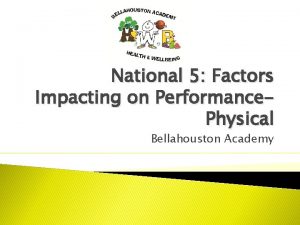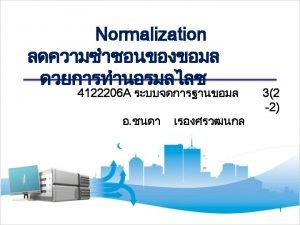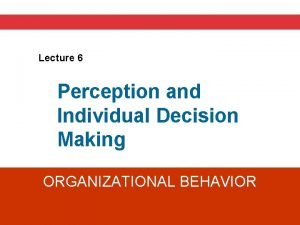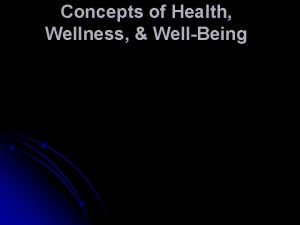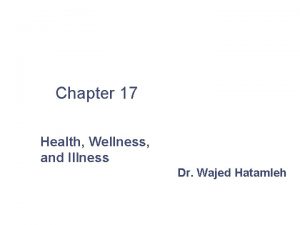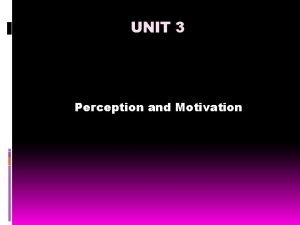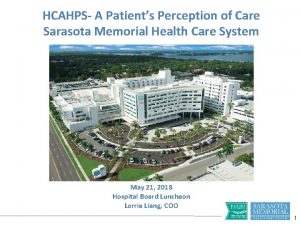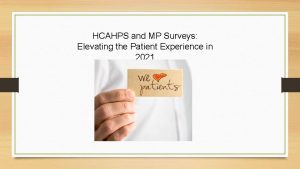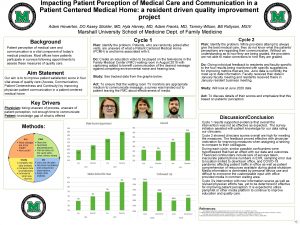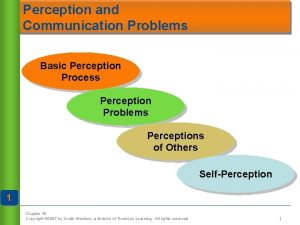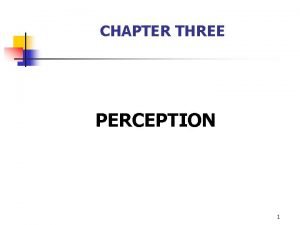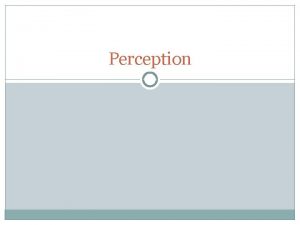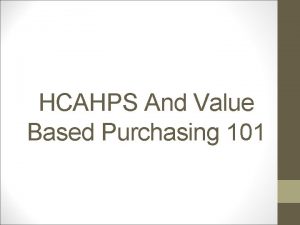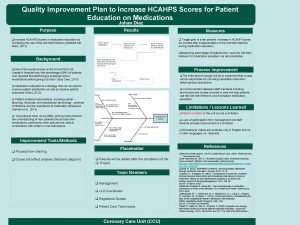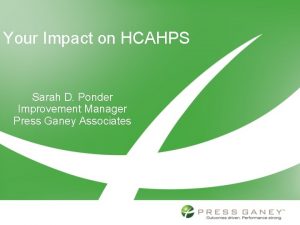HCAHPS Update and Impacting The Patient Perception of
































































- Slides: 64

HCAHPS Update and Impacting The Patient Perception of Care January 28, 2009 Karen Cook, RN, BSN www. studergroup. com Nina Setia, Adm. Director, Service Excellence Hackensack University Medical Center

Webinar Agenda What it is: An Hardwiring Excellence and HCAHPS 15 min Understanding the Data What it is NOT: A tutorial on the survey tool or submitting data. update on HCAHPS data and overview of recommended strategies to improve the patient perception of care. 15 min Priority Initiatives and Cool Ideas 20 min

Nine Principles – A Culture of “Always” ® Commit to Excellence Build Individual Accountability Measure the Important Things Align Behaviors with Goals and Values Build a Culture Around Service Communicate at All Levels Create and Develop Great Leaders Focus on Employee Satisfaction Recognize and Reward Success

Times… They are a Changing… No more denial, blaming rationalization, ignoring results, assuming or hoping… This does not apply to us… we are the only hospital in town…the IPPS payments don’t apply…

HCAHPS Aligns with Industry Trends “…patients and doctors are more likely to base their choice of hospital on non-clinical aspects of a visit – like communication. ”

HCAHPS – Hospital Consumer Assessment of Healthcare Providers and Systems What is HCAHPS Why is it important? How will it be used? A standardized survey tool to measure the patient’s perception of quality care provided during their experience while a patient at an acute-care hospital. The patient perception of care will be publicly reported with other quality metrics on the Hospital Compare website. www. hospitalcompare. hhs. gov The information will be used to provide meaningful data for improvement efforts as well as provide comparisons between hospitals to help consumers choose a hospital.

What Do Patients Want From Us? Communication with doctors Their perception Communication with nurses of our Responsiveness of hospital staff performance is a Pain management reportable and Communication about medicines tangible Discharge information reflection Cleanliness of hospital environment of your Quietness of hospital environment reputation Overall rating of hospital Willingness to recommend the hospital

HCAHPS Aligns with Clinical Quality “Patient-Centeredness” is one of the Institute of Medicine’s key dimensions of Quality and CMS’s Quality Improvement Roadmap vision for Right Care, Right Person, Every Time 1. Safe “Always” is the 2. Effective response scale 3. Patient-Centeredness most highly 4. Timely associated with 5. Efficient loyalty 6. Equitable Institute of Medicine, Crossing the Quality Chasm: A new Health System for the 21 st century, March, 2001

How Will HCAHPS Reinforce Focus on Quality? Patient-Centered care is a quality indicator Quality no longer the domain of just the clinicians Gives a voice to the patient perception of safety Highlights communication issues/barriers Patient-centered care actively involves patients in their care More senior leaders are engaged and interested in delivering patient-centered care

HCAHPS Aligns with CEO’s Top Issues - (2008) Financial Challenges 7%increase Patient Safety and Quality Care for the uninsured Physician- hospital relations Personnel shortages Governmental mandates Patient Satisfaction Capacity Technology Issues about not-for profit status Malpractice insurance Disaster Preparedness American College of Healthcare Executives, 2008, Annual CEO Survey of Top Issues Confronting Hospitals (Patient Safety and Quality are now combined. They were shown separately in prior years Patient Satisfaction 5% increase

HCAHPS Builds the Bridge Between Quality and Service Quality (Factual) What actually happened in the care process… What was the clinical quality/outcome HCAHPS Service (Emotional) How did the patient feel about what happened… How satisfied were they… How often the patient perceived it happened… (Frequency of Process)

A Culture of “Always” and Evidence Based Leadership (EBL) SM gh u kthro a e r B Foundation STUDER GROUP: Leader Evaluation Leader Development Aligned Goals Implement an Create organizationprocess to wide assist leadership in developing evaluation skills and system to leadership hardwire competencies objective necessary to accountability attain desired results (Principle 7) (Principle 4 & 8) Rev 11. 07 Must Haves® Performance Gap Aligned Behavior Must Haves® Re-recruit high and Rounding Thank You Notes middle performers Employee Selection Move low Pre and Post performers Phone Calls up or out Key Words at (Principle 4) Key Times Standardization Accelerators Aligned Process Agendas by pillar Leader Eval Mgr. SM (LEM) Peer interviewing Staff Eval Mgr. SM (SEM) 30/90 day sessions Discharge Call Mgr. SM (DCM) Pillar goals Rounding Mgr. SM (Principle 3, 5, 6, (Principle & 9) 1 & 2) Idea Express. SM

Technology is Driving Change… Consumers will have the same access to medical information as providers have… and more time to explore it 80% of American population use internet - including Baby Boomers Patients will expect more and tolerate less Public reporting is forcing a new direction in patient-centered care Medicare will become the #1 customer of every hospital Source: Health Management Technology, Aug 1999, Harris Poll, 2007 and Press, Ganey

HCAHPS Aligns With A Balanced Approach Passion to make healthcare better Taking Better Care of Patients S E R V I C E Serving the healthcare needs of the COMMUNITY VISION Q U A L I T Y P E O P L E F I N A N C E G R O W T H STANDARDS OF PERFORMANCE: VALUES MISSION

Financial Impact of HCAHPS is voluntary but results must be included in the Pay for Reporting program to receive a full Inpatient Prospective Payment System (IPPS) payment update Penalty does not apply to those not reimbursed by IPPS… Yet. Potential impact: Ø Public reporting will impact patient perception and choice (Service, Quality, and Growth Pillars) Ø Potential downstream impact on revenue if it is tied to pay for performance (Finance Pillar) Ø Financial indicators such as turnover as employees want to work for a quality organization (People Pillar)

A comprehensive performance assessment model is developed… The proposed methodology will score a hospital’s performance and compute an overall VBP score, translating into an incentive payment Will reward hospitals for performance based on attainment in the measurement year or improvement from the prior year’s baseline performance For each measure with a broad differentiation of performance scores, each measure will have a benchmark (top 10%) and an attainment threshold (50 th percentile) based on national data As scores improve nationally, the goals will change There will be different measures for different purposes such as incentive payment, public reporting, and measure development

Potential Plans for Transition to Pay For Performance (Baucus-Grassley Bill Draft) 1. 2. FY 2009: 1 st reporting year for VBP – Payment: 100% public reporting – Measures reported are basis for FY 2009 “attainment” scores; FY 2008 provides baseline for “improvement” calculations FY 2010: 2 nd reporting year – 3. Payment: 50% based on performance, 50% on public reporting (potential) (70% clinical quality and 30% HCAHPS metrics) Impact on rural hospitals is unknown – “The Secretary shall consult with small and rural hospitals on the application of the Program to such hospitals. ” Who knows? ? Bottom line is that we should proceed as if our pay WILL be tied to performance!

www. hospitalcompare. hhs. gov Click this link to find more information on the HCAHPS tool.

Media Coverage Real impact of public reporting will effect reputation Patient choice and downstream revenue Pride and turnover as employees want to work for a quality organization March 29, 2008

Understanding & Impacting the Data Case Study: Hackensack University Medical Center

Quick Facts About HCAHPS Scale - top box will be reported Always, Definitely Yes, % 9 and 10, Yes Measures the frequency of events as perceived by the patients (“how often or did xxxx occur? ”) Never, Sometimes, Usually, Always N – 300 minimum per year Inpatient Adults over 18 years of age; acute care hospitals Case and patient mix adjusted Should be a complementary, not the only tool to be used in identifying performance improvement opportunities (leader rounding, DC Calls, focus groups, verbatim comments etc. ) Should not be considered a new “program” but rather a new method of reporting information

HCAHPS Comparison April 1, 2007 to March 31, 2008 Questions RWH United SG C (all qrtr States Partner ave*) s Nurses always communicated well 78. 4% 75% Doctors always communicated well 83. 7% 80% 79% Patients always received help quickly 72. 4% 62% Pain was always well controlled 71. 6% 68% 70% Staff always explained about medicines 65. 1% 59% Rooms and bathrooms were always kept clean 78. 9% 69% Area around room was always quiet at night 67. 4% 56% 52% Yes patients were given information about recovery at home 80% 81% Patient’s overall rating of hospital (9 & 10) 64% 67% Green SG Partners above US Average Yellow SG Partners equal US Average Yes would definitely recommend this hospital 68% Partners below US Average Red 71%

Sample of Board Communication HCAHPS results: 4 th reporting period (April 2007 -March 2008 discharges)


Estimated Timeline Oct 06 - Jun 07 Discharges Oct 06 – Sept 07 Discharges Jan 07 – Dec 07 Discharges April 07 – March 08 Discharges July 07 – Jun 08 Discharges Suppression linked to loss of APU Oct 07– Sept 08 Discharges Jan 08– Dec 08 Discharges …. but we are REALLY here! Apr 08– Mar 09 Discharges Nov Dec Oct Sep Aug July Jun May Apr Mar Feb Jan Dec Oct Nov Sep 2009 Aug July Jun May Feb Mar Apr Jan Oct Nov Dec Sep 2008 Aug Jul Apr Mar Jan Feb May Jun 2007 2006 Oct Nov Dec We are here: Public Reporting data from April 2007 -March 2008

Past and Current Raw Data reported every two weeks Future

Financial Impact As of March 2009 non-participating hospitals’ Medicare payments run the risk of being reduced by at least 2% under market basket.

Senior Leader’s Adopted Composites: Action Plans Report Quarterly Composite Responsible Leader(s) Communication with Doctors CMO Communication with Nurses CNO Pain Management Chairman of Pain Service Senior VP of Operations Cleanliness of Hospital Environment VP of Operations Quietness of Hospital Environment VP of Operations CNO Responsiveness of Staff CNO Discharge Information CNO Communication about Medicines Administrator, Patient Safety

Nina Setia, featured in Hardwired 9 for the HCAHPS Coaching Track for Nurse Managers

Leader Coaching Track 1 hour a week for 12 weeks Starts with signing a coaching contract Covers Employee Satisfaction for first 2 weeks Includes relevant handouts Contains a competency check at beginning of each session Homework given at last session Evaluation sent and completed electronically CEU’s awarded (can be converted to Nursing contact hours)


Pain Initiative Changed pain policy reflects “acceptability” of pain level Re-assessment within 1 hour “Pain Rule” implemented because pain scores were poor “Red flag” flashes on computer as a reminder to re-assess pain Chairman, Pain & Palliative Medicine began rounding on nursing units in 1 Q 08 Bring pain policy to life and enforced it Provided education to standardize practice within each unit and across all units Rounding with nurses

Pain Initiative: Unit 4 West HCAHPS: • “How often was your pain controlled? • “How often did the staff do everything they could to help you with your pain? ” Patient Satisfaction: • “How well your pain was controlled”

Patient Care Initiatives Quality Leadership Steering Committee for Service Excellence Standardize practices, materials and dashboards Develop internal coaching experts Re-launched hourly rounding on all units Piloted TCAB project (Transforming Care At Bedside) with a goal to increase nurses time at the bedside “Nurses are with me all the time. ” “Quiet Time” for safe administration of medications CEO “Expectation” on discharge phone calls Key words “For safety reasons, nurses will be checking your ID band frequently during your hospital stay. ” Increase time at the bedside = increase in communication = increase in HCAHPS scores

Unit based HCAHPS data

Initiatives Hourly rounding, key words, TCAB Discharge follow up phone calls Re-launched hourly rounding, assessed on discharge phone calls Pain initiative Increased discharge calls, Re-launched hourly rounding “Quiet Time”

Key Initiatives to Deliver Patient-Centered Care Easier Harder Ease of Implementation Top Priority White boards Pre-printed Med Card Leader Rounding Key Words/AIDET Caregiver Engagement Open visitation Noise Audits – Quiet Time Private rooms Hourly Rounding Discharge phone calls Bedside Report/Handoffs Lower Higher Impact on Patient Perception

Communication with Nurses Q 1 During this hospital stay, how often did nurses treat you with courtesy and respect? Q 2 During this hospital stay, how often did nurses listen carefully to you? Q 3 During this hospital stay, how often did nurses explain things in ways you could understand? o o Never Sometimes Usually Always Slide format adapted from Press, Ganey Studer Group Tactics: Individualized patient care Sit at bedside to review care plan White boards Hourly Rounding Bedside Shift Report Peer Interview for communication and empathy talents AIDET Behavior standards

Key Words at Key Times is a Must Have Initiative #1 Key words reflect a communication style that improves the quality of information provided by every person in every interaction Key times are defining moments that: Occur during times of vulnerability – Greetings – first impression – Personal times - like bathroom needs – Handoffs – Goodbyes Are what patients remember and impact the overall perception of the experience

Why are Key Words Important? Reduce patient anxiety Improve patient perception of care Improve coordination of care Decrease law suits “Being Kept Informed” was the MOST important characteristic when “returning to a hospital for future visits. ” 2007 Mc. Kinsey Survey of >2, 000 patients with commercial insurance or Medicaid

Key Words to Build Trust and a Culture of Safety We’ve been expecting you! We have the best radiology department in the city. At our hospital, nothing is more important than your safety. During your stay it is important that each caregiver washes or disinfects their hands before contact with you. This will help decrease the spread of infections and keep you safe. Please do not hesitate to remind us if we forget to clean our hands. Have you seen the staff wash their hands? You are in good hands with Dr. Jones.

Reducing Potential for Litigation Through Better Patient Communication In this Article…. “The most common cause of malpractice suits is failed Communication with the patients and their families. Explore ways that better communication could lead To fewer malpractice claims and allow health care Organizations to reduce litigation costs. ” 1. 2. 3. 4. Focus on Issues: Rounding, AIDET, Key Words Educate the Patient: Rounding, AIDET, Managing Up Enlist the Patient: Rounding, Key Words Share Decisions: AIDET, Key Words Source: The Physician Executive, June 2004

Physician Keywords “I am washing my hands for your SAFETY. ” “I have TIME to answer your questions. ” “I want you to be INVOLVED in your treatment plan” “I want to be sure I EXPLAIN everything to you…” “To protect your PRIVACY, let me close the curtain. ” “For your COMFORT, I ordered pain medicine. . . ” “I want to keep you INFORMED…” “I want to make sure we are THOROUGH” “You are in good hands with the nurses on this floor. ”

The Key to Key Words is PRESENCE Nonverbal behavior – be fully present – Smile, establish and hold eye contact – Put warmth in your voice – Be at THEIR level whenever possible – Face squarely or “heart to heart” Verbal behavior – be fully present – Acknowledge, welcome and use their preferred name – Introduce self and role – Duration - say what you’ll do and what to expect – Explain “I am part of the Albany Medical Center team” – Thank them Adapted from: Heart to Heart Communication – Wendy Leebov

AIDET – Five Fundamentals of Communication A Acknowledge I Introduce D Duration E Explanation T Thank You Decreased Anxiety Increased Compliance + Improved clinical outcomes and increased patient and physician satisfaction

Key Words - Designed Handoff’s A Mrs. Jones you are doing so much better – you can now be on the step down unit. Do you mind if I share a bit about you with Cindy? I I have worked with Cindy for over two years and she will take great care of you. D It will take us about five minutes to discuss your care because I want to make sure she is very familiar with your care plan. E T We want to make sure we keep you informed about your care as well so we will do the report here in the room if ok with you? It has been a pleasure taking care of you and I know you will do well. I am working tomorrow and will check in on you.

Manage Up Co-Workers by Communicating Skill and Training Patient Satisfaction Source: Sacred Heart Hospital, Pensacola, FL

Key Words: Written Material Source: Sierra Vista MC, San Luis Obispo, CA

Key Words

Key Words: Manage UP Co-Workers Managing UP uses keyword phrases to position something or someone in a positive manner Conveys a spirit of teamwork Aligns the organization and demonstrates pride Instills confidence in ability to provide quality care Co-workers appreciate the kind words and the “vote” of confidence as well “Mrs. Smith. This afternoon you will be going to the Cardiac Stepdown unit which means you are closer to going home. This floor has excellent staff and state of the art monitors. They are aware you will be down there this afternoon and are well prepared for you…”

Key Words Customize to reinforce initiatives such as: Individualized Patient Care Rounding for pain goals Managing Up Aligned with other initiatives like Time Out

Rounding for Outcomes is a Must Have Initiative #2 Rounding on Employees, Patients, Physicians and Other Departments • Rounding is a process to PROACTIVELY engage, listen to, communicate with, build relationships with and support the most important customers –Maintains TRANSPARENT communication –Focuses on the positive and what is working well - which is a paradigm shift –Is a requirement of all leaders –Promotes SHARED Decision Making • It is not reactive, focused on “what’s wrong, MBWA, or sporadic when there is “time”

Rounding for Outcomes on Staff “The number one person we round on is the employee. And if we skip the employee, we’re making a mistake. ” Quint Studer, Author of Hardwiring Excellence

Rounding for Outcomes – Employees Rounding on Employees Concern and Care – relationship connection and open lines of communication What is Working Well – focus on positives – Direct reports – 100% monthly (All staff are rounded at least once per quarter) how did you make a difference today? People to Recognize – specific people and actions (other depts, physicians etc. ) Systems to Improve – seek input (safety, rework, pet peeves) Trust but VERIFY behaviors 3 employees x 15 minutes = 45 min + 15 minute F/U = 60 minutes/day Tools and Equipment – barriers to efficiency Follow-up – take notes

Rounding for Outcomes – Patients Nurse Leader Good morning, Mrs. Smith. . . I am Carol, the nurse manager on this unit. Would it be ok if I spent about 3 minutes with you? (sit at the bedside if possible) I see from the whiteboard that Becky is taking care of you. She is an excellent nurse. (managing up is critical piece of leader rounding) On our unit, the expectation is that a staff member is in your room every hour to check on you. Have you seen one of our team members approximately every hour? Have you had to use your call light to ask for pain medicine? Thank you so much for your time. I will be sure to share your compliment with Becky. Is there anything you need before I go? (Follow up with the staff. . . Either on the spot coaching or reward / recognition. )

Selection and Retention of Talent Behavior Standards Initiative #3

Top Five Workplace Incentives 1. 2. 3. 4. 5. Written Thanks From Manager/Executive Team Leader Personal Thanks From Manager Promotion for Performance Public Praise Morale-Building Meetings Study conducted by Dr. Gerald Graham, Management Professor at Wichita State University Motivating Today’s Employees, Bob Nelson Talent+, 1998

Recognition It’s not a natural skill… it must be taught! “ 65% of Americans reported that they received no recognition for good work in the past year…” Source: How Full Is Your Bucket-Tom Rath, Donald O. Clifton

Focus on the Positive Compliment to Criticism Ratio 3 to 1 3 compliments 1 criticism Positive! 2 to 1 2 compliments 1 criticism Neutral 1 to 1 1 compliment 1 criticism Negative Source: Tom Connellan, “Inside the Magic Kingdom”, pgs 91 -95

Behavior Standards – A Culture of “Always” Standards in recruitment and application process Standard of the Month

Are YOU an Effective Team Member? Better able to predict the needs of other team members Provide quality information and feedback Engage in higher level decision making Manage conflict skillfully Understand their role and responsibility Reduce stress on team as a whole through better performance http: //teamstepps. ahrq. gov/abouttoolsmaterials. htm

HCAHPS Toolkit – Aligning Actions to Create a Culture of Always Over 40 evidence-based recommendations to impact the patient perception of quality Will be sent by Mary Jon Order today at www. studergroup. com

The Right Thing to Do Leader Rounding and Key Words/Managing UP Ensures strong communication Promotes a sense of “well-being” Decreases anxiety Exceeds expectations Provides “individualized” care Do I take responsibility and ownership of my department? Do I Manage Up my team and my organization?

It is not about scores, financial indicators, public reporting, % of always…it is about compassionate care and saving lives
 Hcahps top box definition
Hcahps top box definition Alternative of log based recovery
Alternative of log based recovery Social factors examples pe
Social factors examples pe Factors impacting performance national 5 pe
Factors impacting performance national 5 pe Factors impacting performance
Factors impacting performance Einflussfaktoren der kommunikation
Einflussfaktoren der kommunikation Patient 2 patient
Patient 2 patient Product knowledge food and beverage service
Product knowledge food and beverage service Hát kết hợp bộ gõ cơ thể
Hát kết hợp bộ gõ cơ thể Slidetodoc
Slidetodoc Bổ thể
Bổ thể Tỉ lệ cơ thể trẻ em
Tỉ lệ cơ thể trẻ em Chó sói
Chó sói Chụp tư thế worms-breton
Chụp tư thế worms-breton Chúa yêu trần thế alleluia
Chúa yêu trần thế alleluia Môn thể thao bắt đầu bằng từ đua
Môn thể thao bắt đầu bằng từ đua Thế nào là hệ số cao nhất
Thế nào là hệ số cao nhất Các châu lục và đại dương trên thế giới
Các châu lục và đại dương trên thế giới Công của trọng lực
Công của trọng lực Trời xanh đây là của chúng ta thể thơ
Trời xanh đây là của chúng ta thể thơ Mật thư anh em như thể tay chân
Mật thư anh em như thể tay chân 101012 bằng
101012 bằng Phản ứng thế ankan
Phản ứng thế ankan Các châu lục và đại dương trên thế giới
Các châu lục và đại dương trên thế giới Thơ thất ngôn tứ tuyệt đường luật
Thơ thất ngôn tứ tuyệt đường luật Quá trình desamine hóa có thể tạo ra
Quá trình desamine hóa có thể tạo ra Một số thể thơ truyền thống
Một số thể thơ truyền thống Cái miệng bé xinh thế chỉ nói điều hay thôi
Cái miệng bé xinh thế chỉ nói điều hay thôi Vẽ hình chiếu vuông góc của vật thể sau
Vẽ hình chiếu vuông góc của vật thể sau Biện pháp chống mỏi cơ
Biện pháp chống mỏi cơ đặc điểm cơ thể của người tối cổ
đặc điểm cơ thể của người tối cổ Ví dụ về giọng cùng tên
Ví dụ về giọng cùng tên Vẽ hình chiếu đứng bằng cạnh của vật thể
Vẽ hình chiếu đứng bằng cạnh của vật thể Fecboak
Fecboak Thẻ vin
Thẻ vin đại từ thay thế
đại từ thay thế điện thế nghỉ
điện thế nghỉ Tư thế ngồi viết
Tư thế ngồi viết Diễn thế sinh thái là
Diễn thế sinh thái là Dạng đột biến một nhiễm là
Dạng đột biến một nhiễm là Các số nguyên tố
Các số nguyên tố Tư thế ngồi viết
Tư thế ngồi viết Lời thề hippocrates
Lời thề hippocrates Thiếu nhi thế giới liên hoan
Thiếu nhi thế giới liên hoan ưu thế lai là gì
ưu thế lai là gì Hổ đẻ mỗi lứa mấy con
Hổ đẻ mỗi lứa mấy con Sự nuôi và dạy con của hươu
Sự nuôi và dạy con của hươu Sơ đồ cơ thể người
Sơ đồ cơ thể người Từ ngữ thể hiện lòng nhân hậu
Từ ngữ thể hiện lòng nhân hậu Thế nào là mạng điện lắp đặt kiểu nổi
Thế nào là mạng điện lắp đặt kiểu nổi Sql queries for insert update and delete
Sql queries for insert update and delete Data redundancy and update anomalies
Data redundancy and update anomalies Chapter 5 sensation and perception
Chapter 5 sensation and perception Chapter 7 vision and perception
Chapter 7 vision and perception Papi test
Papi test Perception and individual decision making
Perception and individual decision making Reversible figure ground relationship
Reversible figure ground relationship Eudemonistic model
Eudemonistic model Perception and decision making in organizational behavior
Perception and decision making in organizational behavior Subjective perception of vitality and feeling well
Subjective perception of vitality and feeling well Perceptual set ap psych
Perceptual set ap psych Development of binocular vision
Development of binocular vision Motivation and perception
Motivation and perception Sensation psychology
Sensation psychology Sensation and perception crossword review
Sensation and perception crossword review



